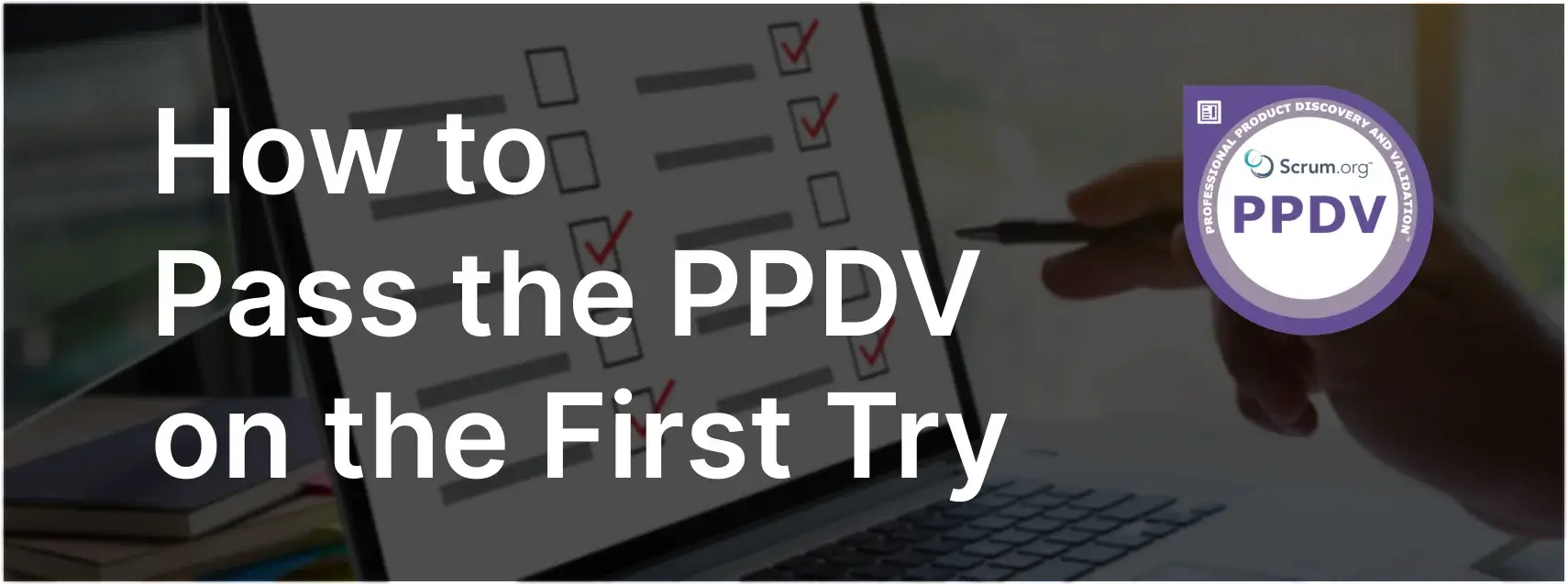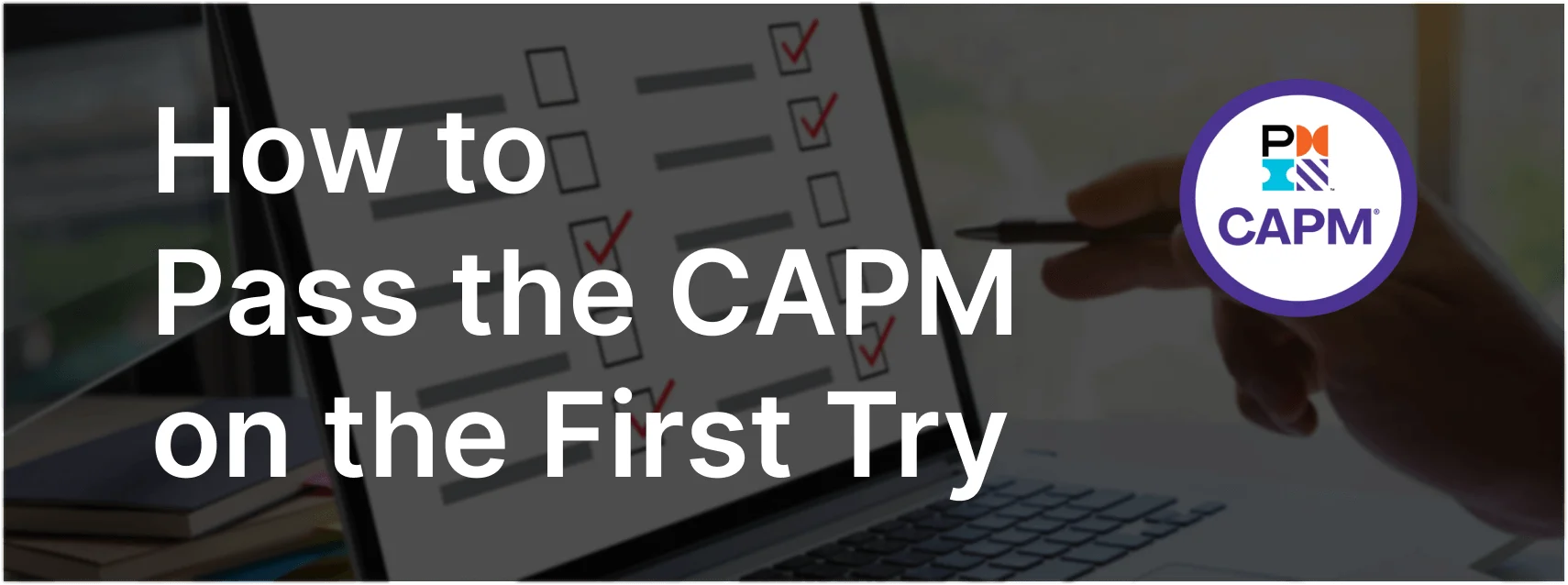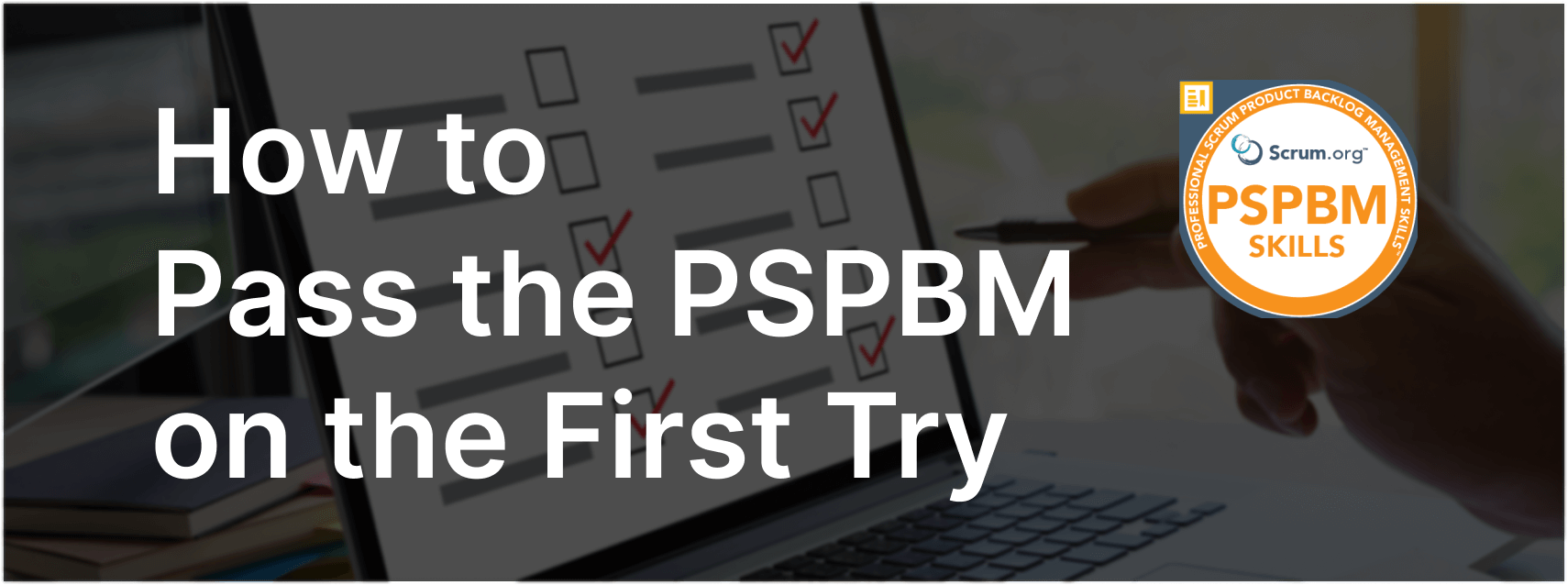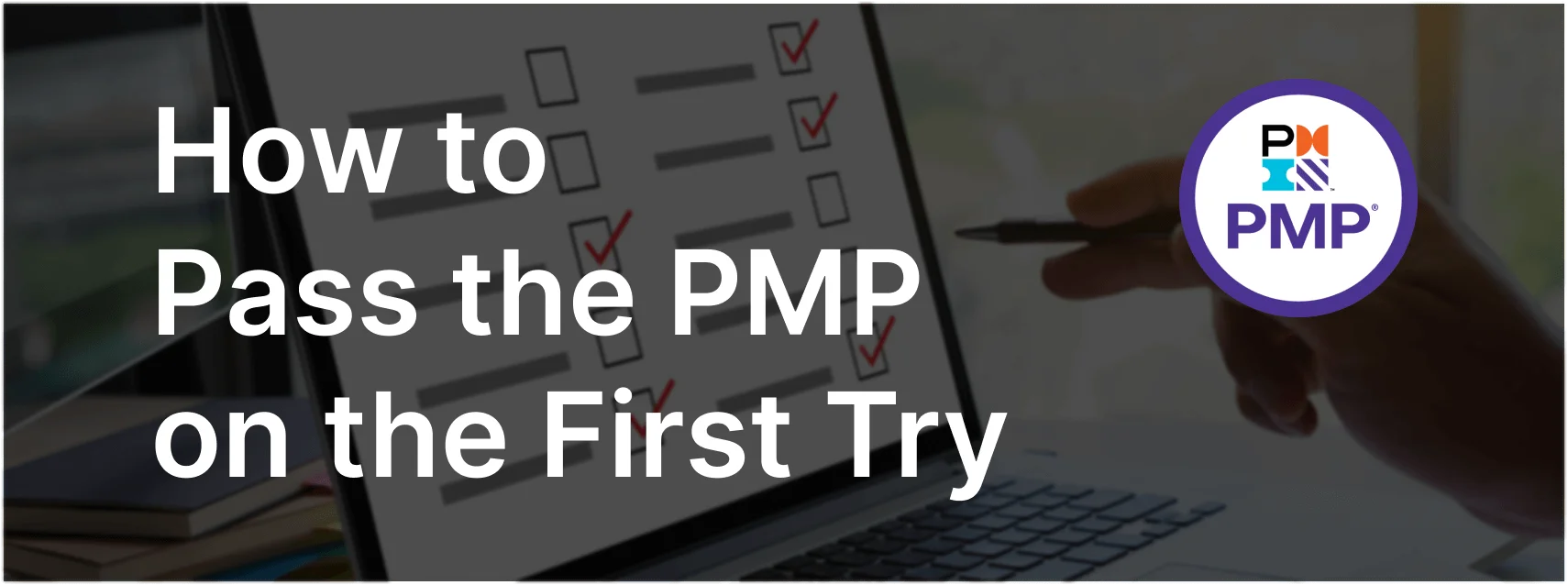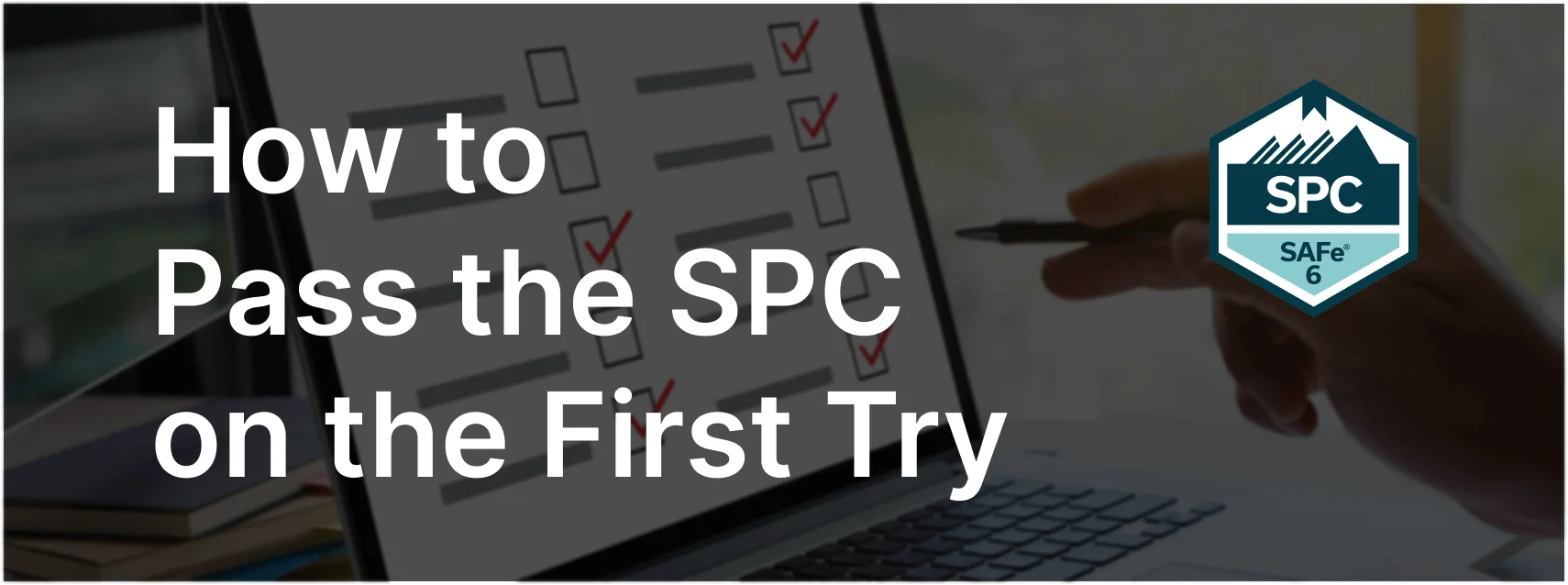First, I’ll show you a breakdown of the structure of the assessment exam.
Then, I’ll help you get ready for taking the exam.
Sounds good? Let’s dive right in…
Get the extra confidence boost for the PSM I exam
You’ve learned all that needs to be learned about the Scrum Framework but not quite ready to bet $150 on your exam attempt. If this feels familiar, then you’re in the right place.
Because today I’m going to show you the exact techniques that I use and help others use to consistently and confidently score 100% on the PSM I exam.
1. You only get 60 Minutes to answer 80 Questions
First-time test-takers will be typically concerned about the number of questions, the time limit, and the minimum 85% passing score. To break it down, it means you will need to answer at least 68 out of 80 questions correctly within 60 minutes.
The purpose of this format is to ensure that you have truly mastered the fundamentals.
PSM I Time Management Technique
As you should already know, it’s important to manage your exam time effectively but the PSM I takes it to the extreme.
If you were to average 45 seconds per question then you would need the entire 60 minutes to finish the entire test. However, it’s not quite that simple. Depending on a person’s knowledge level, the difficulty levels between questions will vary. Some will take just seconds to answer whereas others might require much more thinking.
The technique below is one that I’ve created and use frequently to simplify the exam tracking process. Following this process will allow you to dedicate more focus towards answering questions and less the timer.
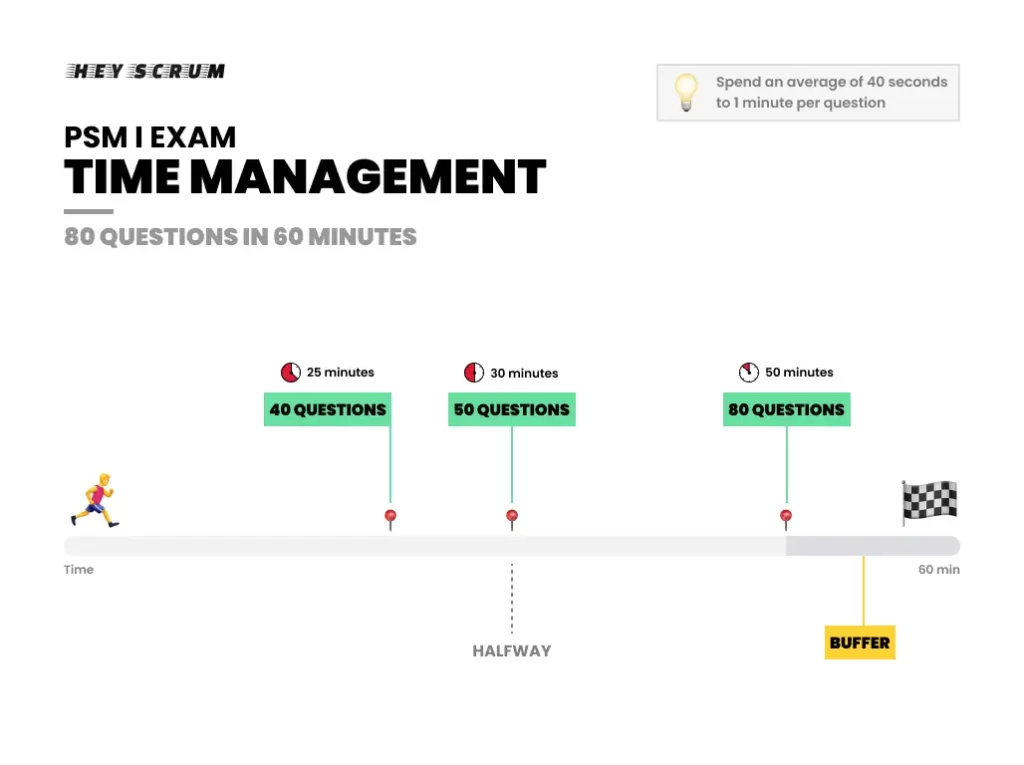
The first major checkpoint should be the halfway point of either the questions or the time. Allowing enough time buffer will give you room to adjust your pace and revisit questions if needed.
Considering a 10 minute buffer, you should be on question #40 (halfway through the questions) when you have 35 minutes remaining. At the 30 minute mark (halfway through the time), you should be on question #50. Take notice when you’re halfway through either the time or questions. At at these points, it will be easier to determine whether your pace is good or if you need to spend less time on the remaining questions.
Within each half of the exam, it is also helpful to get a feel for whether you’ve spent too much time on a question. With a 10 minute buffer, you should be averaging around 40 seconds per question. If you’re spending more than 1 minute on a question, do a best guess, note the number down, and continue to the next question. You can revisit the question later.
Keep an eye on your general progress but don’t make it more of a distraction than it needs to be.
2. Bookmarking questions
There are a number of reasons why you might want to revisit a question. Double-checking an answer, needing time to read it more thoroughly, trying to better interpret the question or answers, etc. In any case, you’ll need to physically write it down.
Because of the exam time-box, you’ll need to manage this list carefully as you might not have enough buffer time to revisit them all.
Prioritizing your list will make it easier to choose the questions that you want to revisit first as you may not have enough time to get through the entire list.
The technique below is one that I’ve created and use to simplify how to bookmark questions and maximize your return on investment when revisiting them.
MusCoNi — the PSM I bookmarking method
This method was created when I experienced difficulties remembering which questions were the most important to revisit (and also because I had bad handwriting). This quadrant type system will not only make it faster to bookmark question numbers but also categorize them to make it easier to prioritize.
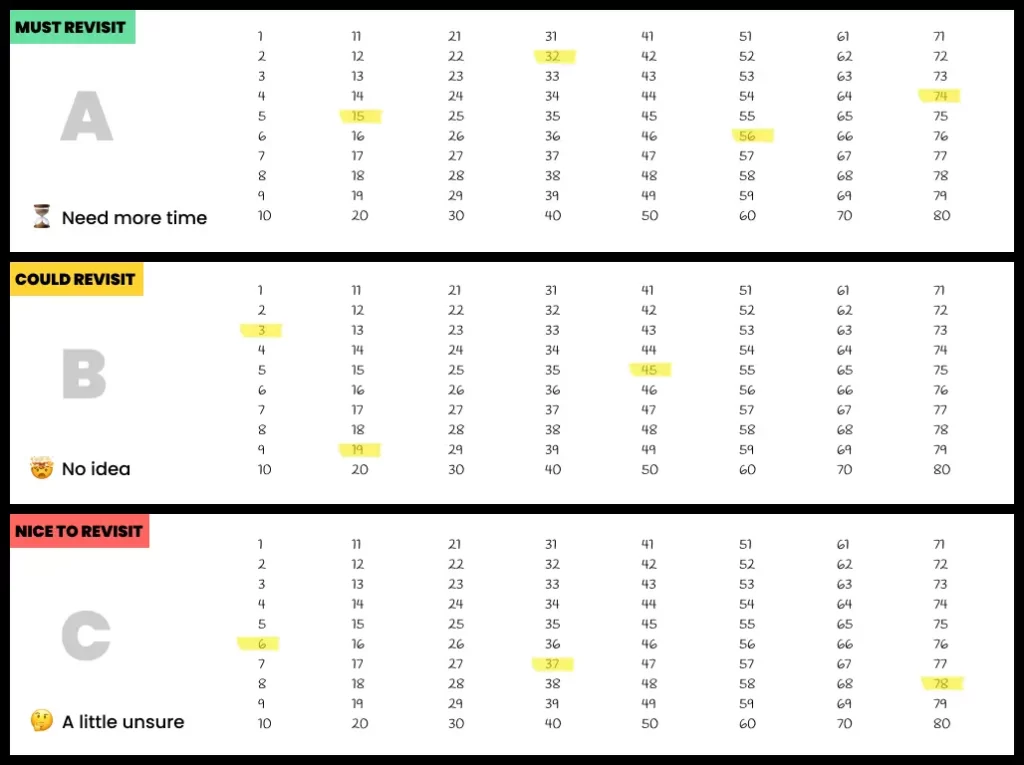
Similar to the MoSCoW method but for PSM I exam bookmarking, the MusCoNi 😂 has three different types of initiatives:
A) Must revisit: are ones where revisiting it will have a good chance of increasing your score.
B) Could revisit: are ones that are outside of your current knowledge and require a lot of time for researching.
C) Nice to revisit: are ones where you’re pretty confident with your answer but want to double-check just in case.
How to use the bookmarking tool
- Download and print the MusCoNi tool
- As you’re taking the exam and find a question you want to revisit, decide which category it should fall into.
- Highlight the question number in your selected category.
- When all 80 exam questions have been answered, use the MusCoNi sheet to decide which highlighted question numbers you want to revisit.
When working through your bookmarks, it is best to start with Must revisit as the risk/reward is typically in your favor. Answers are typically on the tip of your tongue and you might get a new perspective through revisiting them.
Work through the Could revisit when the Must revisit is empty. Depending on the context of the question, you can apply a process of elimination on the answers or try to Google the answers. Note that a lot of resources on the internet are incorrect.
Nice to revisit should be last as spending more time on them is unlikely to increase your score. In fact, it might even decrease your score if you end up overanalyzing the question.
Note: During the exam, answers must be submitted before you are allowed to go to the next question. Hence, you cannot leave an answer blank in order to revisit later.
Having a simple system to organize your bookmarks will help to save time and increase your chances of improving your score.
3. Question types
The exam is composed of 3 question types. Below is a breakdown of the approximate ratios:
- Multiple Choice : ~65% (~52 questions)
- Multiple Response : ~30% (~24 questions)
- True / False : ~5% (~4 questions)
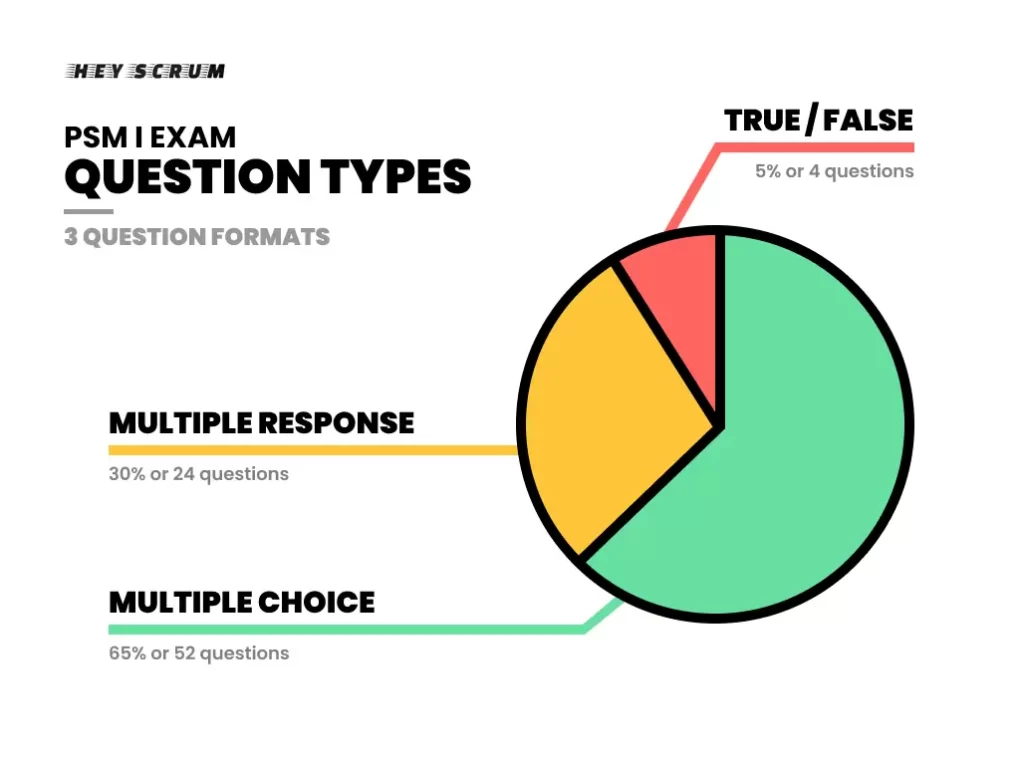
(choose the best answer) and (choose the best # answers)
Not all questions will contain answers that are purely right or wrong, there will also be some cases where any answer can be valid however you can’t choose them all. Keep in mind that you are seeking the best answer(s) rather than the right answers.
Be aware that there can be questions where it might seem to elicit multiple answers but there really is only one that is correct. ie Multiple Response with only a single valid answer.
Example of a Multiple Response question:
Which of the following is true about the first Sprint?
(choose the best two answers)
☑️ It results in a potentially releasable Increment.
🔲 It is focused on creating Sprint Backlogs for subsequent Sprints.
☑️ At least one piece of functionality is developed.
🔲 It is used to determine and finalize the project plan.
🔲 The first Sprint should not begin until the architecture and infrastructure is in place.
True / False
Focus on whether you believe the presented statement is true or not rather than thinking about whether an opposite statement is true or not. A True/False question is only asking about the presented statement, so don’t overanalyze by justifying your answer by seeking an opposite statement.
Example of a True/False question:
True or False: Scrum is a method to incrementally build software through specifically defined steps and processes.
⚪️ True
🔘 False
Understanding how the exam is structured and how the question types work will allow you to focus more on the context of the questions.
4. Easy, Hard, and Tricky Questions
Some questions will be easier than others. Below are the types of questions new exam takers will experience.
“Easy” questions
I consider anything that can be explicitly found in the Scrum Guide as an easy question. For example, time-boxes, which events are used for what purpose, what are the artifacts, etc. If you know and remember the specific contents of the Scrum Guide, you should have no problem answering these types of questions.
Example of an “easy” question:
Which of the following are accountabilities defined in Scrum?
(choose all that apply)
☑️ Developers
🔲 End Users
🔲 Stakeholders
☑️ Product Owner
☑️ Scrum Master
“Harder” and not so obvious questions
These answers typically cannot be found in the Scrum Guide but are implicit so will involve a bit deeper thinking. The Scrum Guide is written with the assumption that you understand the underlying concepts and foundation from which Scrum is built.
Example of an implied question:
Which of the following is considered the desired benefit of having time-boxes?
(choose the best answer)
🔘 Helping to limit work-in-progress.
⚪️ Ensuring that all planned items will be finished on time.
⚪️ Maximizing the velocity of the Developers.
⚪️ Helping the Product Owner determine which “Iron Triangle” attribute to adjust.
“Tricky” questions
If a question feels like a trap or ambiguous, reread the question and all answers carefully. Questions are not meant to trick you and there are no “trick questions”.
Remember, the exam assesses your knowledge and understanding of Scrum and only focuses on that. The grammar and vocabulary of the questions are important to correctly interpret the question and will make answering it much easier.
Separate your personal experience. There’s a good chance that your organization used Scrum incorrectly. Some questions will focus on common anti-patterns and bad habits when Scrum is done wrong. For example, there are no Sprint 0 or hardening Sprints in Scrum.
Example of question that might feel tricky:
Which of the following is Product Owner work that the Product Owner might delegate?
(choose the best answer)
⚪️ Writing User Stories.
🔘 Ordering the Product Backlog.
⚪️ Updating the Scrum Board.
⚪️ Attending the Sprint Planning.
⚪️ Creating acceptance criteria.
5. Things that are not in the Scrum Guide
Not all questions will focus on the Scrum Guide. Because it’s a framework, you will need to know how to detect when boundaries are violated.
Tools, practices, and processes not mentioned in the Scrum Guide
There will be some terms that are external to Scrum but can be used to help Scrum Teams. You won’t need to be a knowledge expert, however, it’s good to know how certain tools and practices can be used within the Scrum Framework.
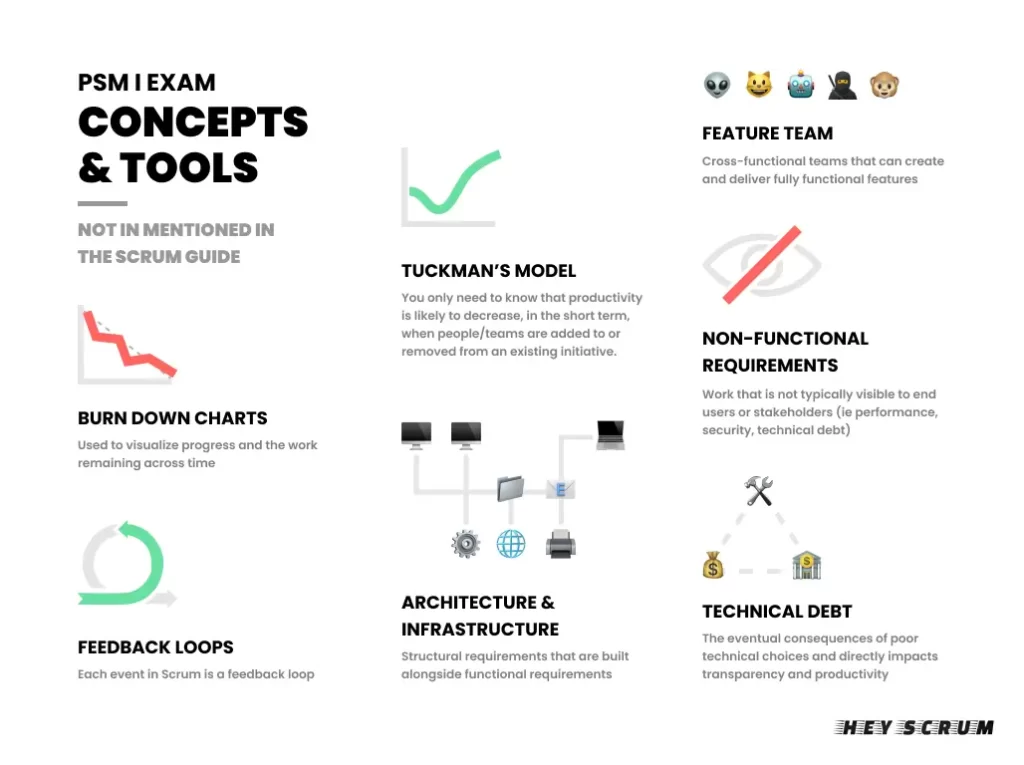
Below are some concepts, tools, and practices mentioned on the exam and what you should know:
- Burn-down charts — used to visualize progress and the work remaining across time
- Feedback loops — each event in Scrum is a feedback loop
- Tuckman’s model — you only need to know that productivity is likely to decrease, in the short term, when people/teams are added to or removed from an existing initiative.
- Architecture & Infrastructure — structural requirements that are built alongside functional requirements
- Feature teams — cross-functional teams that can create and deliver fully functional features
- Non-functional requirements — work that is not typically visible to end-users or stakeholders (ie performance, security, technical debt)
- Technical Debt — the eventual consequences of poor technical choices and directly impacts transparency and productivity
Example of a tools question:
Sprint burn-down charts can be helpful:
(choose the best answer)
🔘 To indicate the total work remaining for the Sprint.
⚪️ To know how many hours each Developer has worked.
⚪️ For the Scrum Master to manage the tasks.
⚪️ To indicate if more people are needed on the team.
6. Questions that deep dive
Being only 13 pages long, the Scrum Guide only provides just enough information on different elements of the framework. You will need to know how the different components are correlated and why each part of Scrum is necessary. The answers cannot be directly found in the Scrum Guide but goes further into the underlying foundation. For example, why is it important that there is only one Product Owner per product? Or what happens if the frequency of the Daily Scrum were to be reduced?
Deep dive questions typically focus on:
- What a self-managing team looks like
- What a cross-functional team looks like
- How each component impacts transparency
- The types of behavior that results from the Scrum values
- Understanding the meaning of “complex”
- The correlation between empiricism and the complex domain
- The types of behavior that result from the Scrum value of commitment
- How risk is managed in Scrum
So in addition to assessing what you know, the exam will also assess whether you understand what you know.
Example of a deep dive question:
In the context of Scrum, an empirical approach is used to address which problem domain?
(choose the best answer)
⚪ Simple problems
⚪ Complicated problems
🔘 Complex problems
⚪ Chaotic problems
⚪ Novel problems
7. Scenario-based questions
Scrum in practice.
The Scrum framework is purposely incomplete and only guides the relationships and interactions of the people using it. As such, there will be some questions describing scenarios and asking how to best respond within the context of Scrum.
If the question is asking how a Scrum Master should respond to a problem people are having, the best answers would be anything connected to coaching, mentoring, teaching, facilitating, or supporting the team in self-problem solving. Answers that suggest a Scrum Master agree with or disagree with an opinion or prescribing a solution are usually incorrect. For example, what a Scrum Master should do if a Developer notifies him of a data security issue.
Example of a Scrum Master scenario question:
As a Scrum Master, what should you do if a Developer tells you that he discovered a critical security issue?
(choose the best answer)
⚪ You confirm the issue with the test team.
⚪ You create a new item in the Product Backlog to fix the issue.
⚪ You add it to the Definition of Done.
🔘 You ask the Developer to share the issue with the Scrum Team as soon as possible.
⚪ You postpone the Sprint until the issue can be resolved.
If the question is asking how a Product Owner or Developer should respond when faced with a problem, the best answer would be one that has the most flexibility. The best answers are the ones that are related to transparency, self-managing, and enacting one of the Scrum values.
Example of a Developer scenario question:
What should a Developer do if an influential stakeholder asks him to work on an important item that was not a part of the Sprint Planning?
(choose the best answer)
⚪ Add it to the bottom of the Sprint Backlog.
⚪ Replace an item with equal size in the Sprint Backlog.
⚪ Immediately work on the item and continue on Sprint Backlog items after it has been completed.
🔘 Notify the Product Owner so he can work with the stakeholder.
8. Randomized questions and answers
All questions are randomly pulled from a master question bank. Of all of the certifications, the PSM I has the largest master question bank which is approximately 200–300 questions in total. Each of the 80 questions will be randomly pulled from the master question bank and answers can be randomly ordered so no two exams will be exactly alike.
Questions are continuously refined, added, and removed throughout the year in order to improve the assessment. This also makes many practice questions found online quickly obsolete.
9. Question Categories
The master question bank is further divided into specific categories. All of the questions in the exam will cover one of these categories. However, some categories will have more or fewer questions than others.
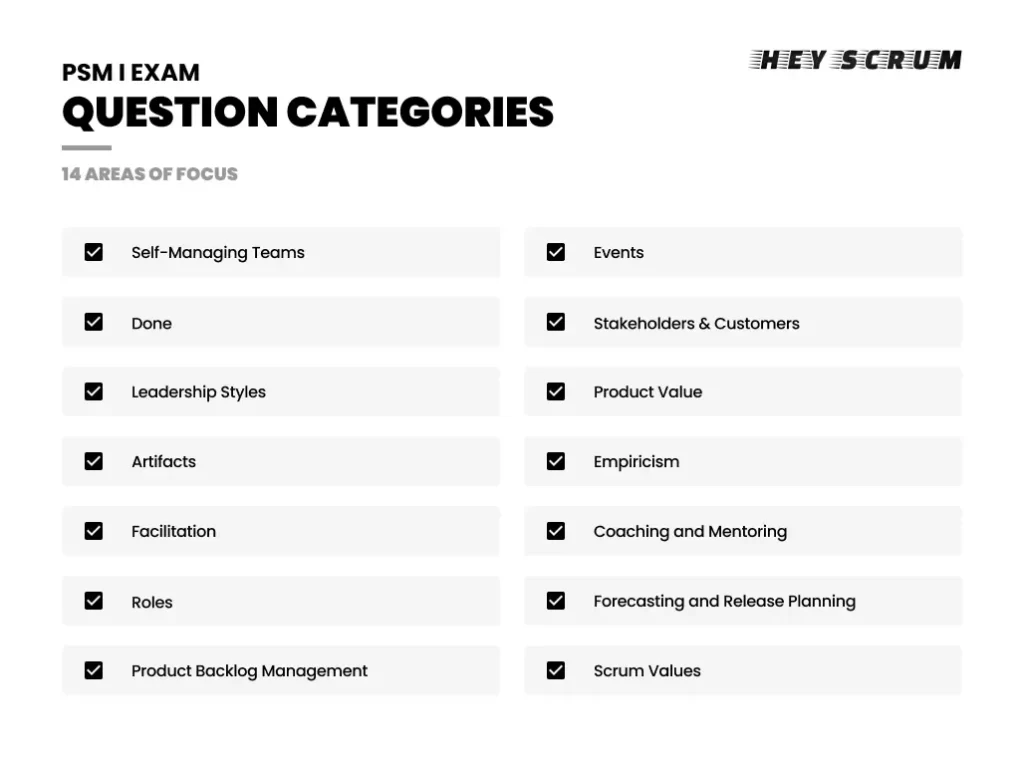
10. What to do if you don’t know the answer
If you absolutely know that you don’t know the answer then don’t spend too much time trying to figure it out. Go with an answer that is aligned with guidance, coaching, teaching, etc. rather than an answer that prescribes a solution. Scrum does not endorse “Best practices” as they cannot be applied across all contexts and situations.
If you know you don’t know then, note down the question number in the Could Revisit quadrant (see Bookmarking Questions above) and revisit if there’s time remaining.
Additionally, it’s good to note down the question details and information so you can research and improve your personal knowledge for the future.
11. Question load time issues
Because of the technology being used to deliver the exam, the loading time between questions will count against your remaining time. So if it takes 10 seconds for a question to load then it will deduct those 10 seconds from your remaining time.

If a new question does not load immediately, the exam will automatically display a notification to wait. This notification will include a “click here” to reload the page.
What to do if you’re having loading issues:
- If it’s taking more than 10 seconds to load, reload the page either by the exam notification or by refreshing your browser.
- If the exam is still having issues loading, disconnect and reconnect to the internet.
- Note down if you’re consistently experiencing long load times between questions. This will be helpful below.
What to do if you failed because of load time issues:
- Immediately email Scrum.org explaining your situation.
- Include details on approximately how much time was spent waiting and how often you had to wait.
Scrum.org is helpful when it comes to technical exam issues. They will review your exam analytics and if they agree with your grievance, they will add additional time and let you revisit your exam again.
Tips to reduce the risk of load time issues:
- Ensure you have a good internet connection.
- If possible, try not to switch between networks during the exam.
12. Finishing the exam
Happy with all questions and still have time to spare? This would be a good opportunity to note down any questions you’d like to dive deeper into after the exam. The knowledge gained will be helpful if you decide to take the PSM II exam.
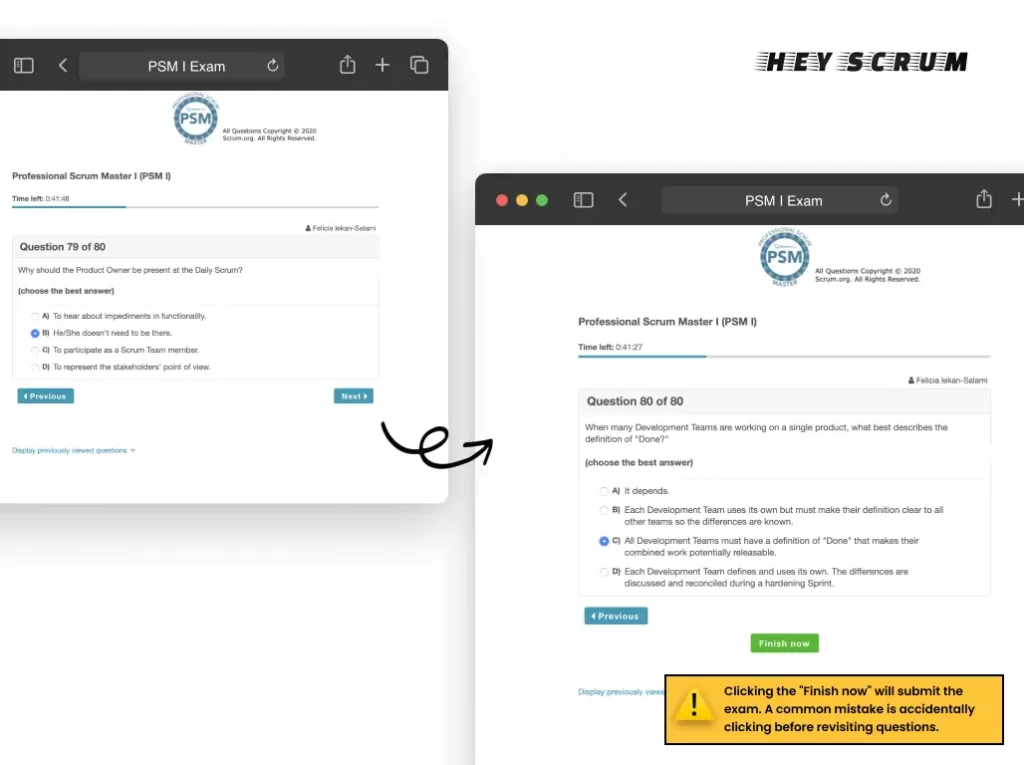
The exam will be submitted when you click the “Finish now” button or automatically when the time expires. If you are revisiting questions, the “Finish now” button will also appear at the bottom of the question so you do not need to go to the last question to submit the exam.
A common mistake that occurs is forgetting your progress and accidentally clicking “Finish now” when you still want to revisit questions. Once the exam is submitted, you cannot go back again. So pay attention when you’re getting close to the end of the exam.
13. Exam results
The results will not tell you which questions were answered correctly or incorrectly. You will only be provided with a general score and boxed feedback.
After the exam is submitted you will be sent your scores and added to the searchable Scrum.org database.
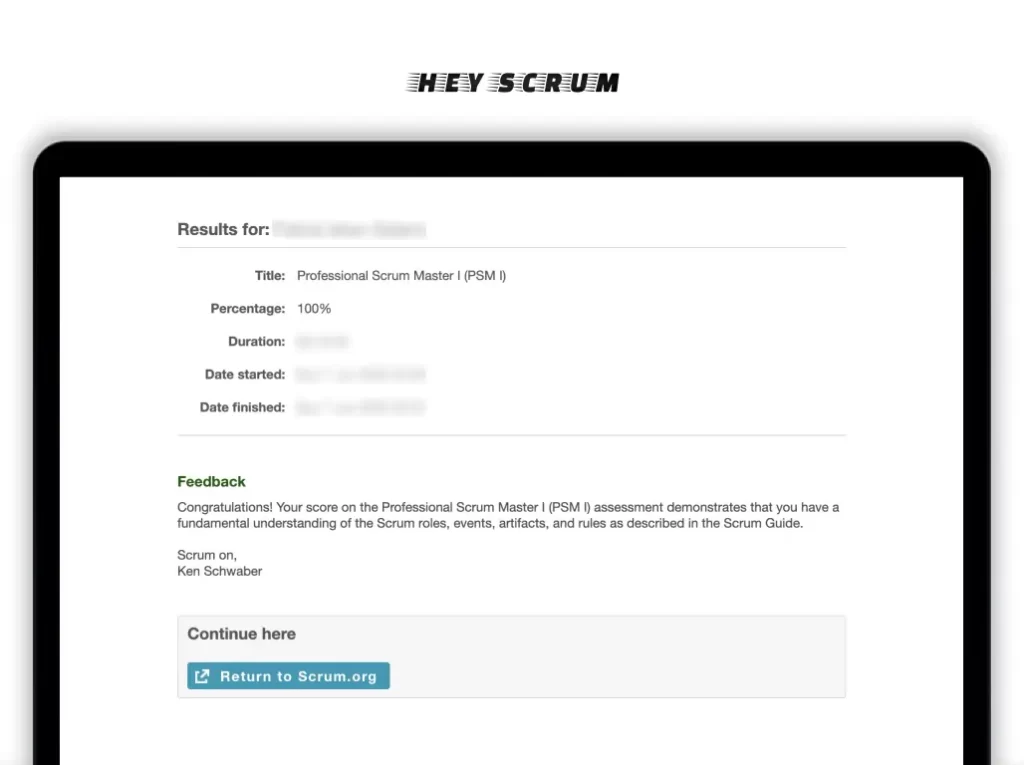
A Percentage Score and Pass/Fail feedback will be displayed in the browser.
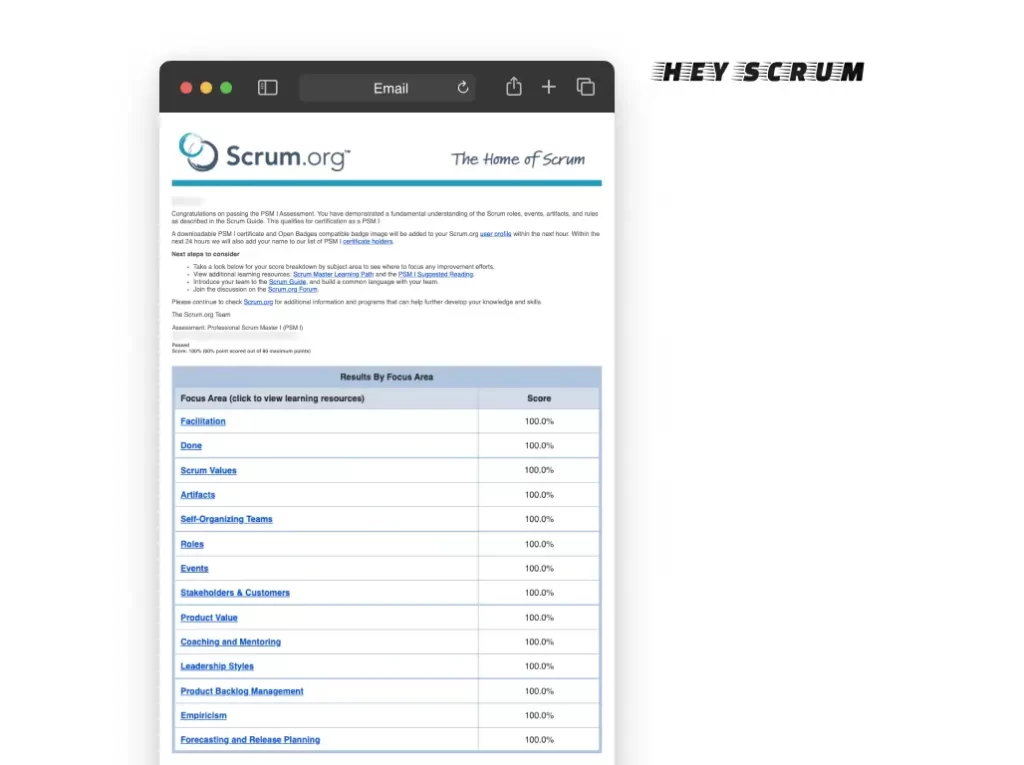
An email will be sent with the number of points scored and a score breakdown by Focus Area.

And results will be saved to your scrum.org profile and logged in their database.
You can take the exam again if you’re wanting to increase your score. For example, if you’re pursuing a Professional Scrum Trainer (PST) certification you must achieve a minimum score of 95% on the PSM I assessment.
14. Did I Miss Anything?
Now I’d like to hear from you:
Which strategy from today’s post are you going to try?
Or maybe I didn’t mention one of your favorite PSM I exam insights.
Either way, let me know by leaving a comment below right now.


